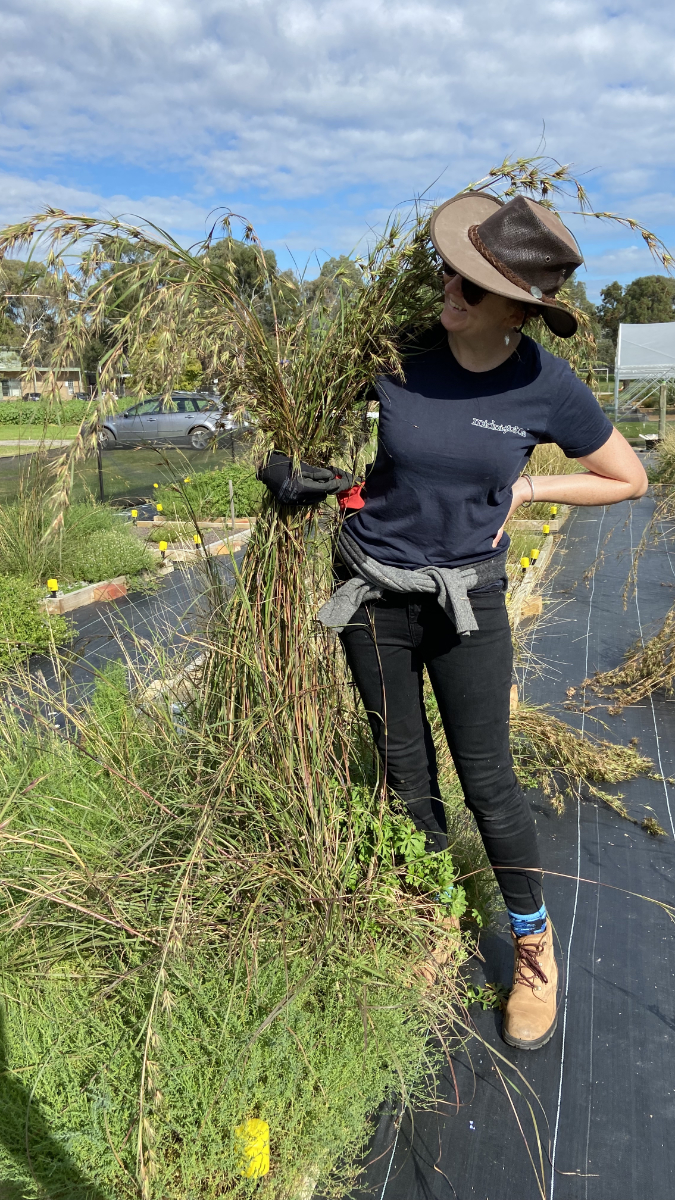5 Minute read
Life as a graduate researcher: Katherine Horsfall
Recovering from a car accident spurred Katherine Horsfall to pursue her passion in horticulture. Now she is bringing biodiversity – and beauty – back into Melbourne’s suburbs. Her PhD is helping her build industry connections and develop her business ideas.
Biodiversity is important for the health of our environment.
“I get a little bit sick and tired of seeing the same plants planted over and over again in our suburbs,” says Katherine Horsfall. She is a science PhD candidate at the University of Melbourne.
Katherine is working to transform urban spaces into beautiful wildflower meadows using species from critically endangered grasslands and grassy woodlands.
“If we're introducing more native wildflowers, we're providing resources, for instance, to native bees that co-evolved with those plants,” Katherine says.
Humans appreciate Katherine’s meadows, too.
“We're giving people the opportunity to stop and reflect on nature. And that has really great mental health and social outcomes,” she says.

I also think it's an important act of reparation that's a part of our reconciliation journey, part of the work we need to do to address the fact that agriculture and urban development has resulted in the destruction of these landscapes. Katherine Horsfall
Exploring a passion for a greener world

Katherine has wanted to make cities greener and more liveable for a long time. She has developed policies for greening cities and towns for the Victorian government. But a car accident forced Katherine to pause her career.
“I had long been interested in pursuing the Master of Urban Horticulture but it was the car accident that finally made me make the move,” she says.
Katherine completed a short research project on grassland restoration as part of her masters degree. The City of Melbourne partnered with her on the project.
“It has been an amazing experience to work with the City of Melbourne to find practical ways to achieve policy goals to improve biodiversity,” Katherine says.
Restoring grassland plants on urban sites is notoriously difficult due to weed competition and changed soil conditions. Katherine wanted to develop reliable and affordable methods to do this.
“My pilot project gave me the idea of using horticultural techniques to create native wildflower meadows, but it was obvious that more work was needed to refine and evolve these ideas,” she says.
What is a PhD like for a professional returning to university?
With the City of Melbourne keen to stay on as a partner, Katherine continued to a PhD in Science. Staying at the Burnley campus was an easy decision.
Burnley has been a centre for teaching and research in urban horticulture since 1891.
The Burnley campus has a really great community of people who all love plants, but they're also really driven to make our cities greener and more liveable Katherine Horsfall

Her masters focused on coursework. In comparison, Katherine finds the PhD to be much more like a professional job.
“A PhD is very much about developing and constantly evolving an approach, an idea, a body of work,” Katherine says.
And it’s paid. Katherine receives an Australian Commonwealth Government-funded Research Training Program Scholarship. Other scholarships are also available to support graduate researchers.
A PhD creates industry connections and business opportunities
Katherine’s PhD has given her opportunities to connect with industry partners.

Even in the context of COVID-19, I've still managed to make a great number of connections with people who work in worlds that I'm interested in working in: councils, big public landscape contractors, and people creating real material change to our urban fabric. Katherine Horsfall
Katherine now knows a lot about how Victoria’s indigenous plant species behave in an urban environment. She founded Melbourne Meadows to help people create beautiful native meadows.
The University of Melbourne’s TRAM Runway program helped Katherine explore the idea. The 12-week startup accelerator gives advice on how to turn research into a business.
“It was an education in some of the approaches you might take to raising capital and to creating a sustainable business that could keep growing over time,” she says.
"It's a bit of a whirlwind, but I think it touches on all these things that maybe you haven't thought about previously. If you do decide to pursue an entrepreneurial journey, you've got a really solid grounding as a result of a program like TRAM Runway.”
She’s currently focused on completing her thesis. But Katherine sees incredible potential for the business. She would like to expand from consulting to supplying tailored seed mixes. And she’d like to expand her clients from city councils to homeowners.
Meanwhile, the wildflower meadow research continues. Katherine's research group has recently received Australian Research Council Linkage program funding.
“We've got six councils, two commercial partners and a not-for-profit partner. This project is all about how we repurpose urban construction waste to create these native wildflower meadows,” Katherine says.
Katherine would love to stay involved with the research beyond finishing her PhD.
“This partnership will result in making new meadows, which gets me out of bed in the morning. But it will also help us understand how we can do this more sustainably.”
Banner image: Photograph by David St George
First published on 3 April 2024.
Share this article
Keep reading
-
Why research with us
Explore the benefits of undertaking your graduate research at the University of Melbourne.
-
Your research options
Explore your options as a graduate researcher at the University of Melbourne.
-
Your study experience
Discover what it's like to be a graduate researcher. Find out about University life, support services, and opportunities for skills development.
-
How to apply
Find out how to apply for graduate research at the University of Melbourne.